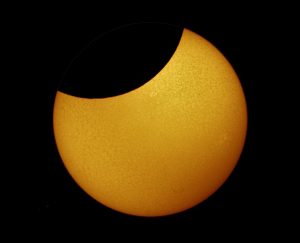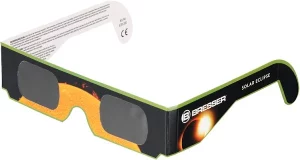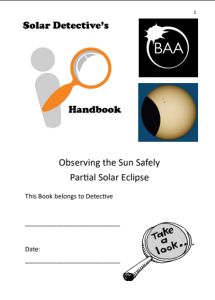2025 March 22
Partial Solar Eclipse – 29 March 2025
On the morning of Saturday March 29th there is a special event – a partial eclipse of the Sun – when the Moon moves between the Earth and the Sun https://www.timeanddate.com/eclipse/partial-solar-eclipse.html.

There will not be any noticeable dimming of sunlight. But, watching the Moon take a bite out of the Sun is fun!
Different points on Earth have different vantage points, hence some parts see greater coverage of the Sun than others. From the UK the eclipse starts around 10 am and finishes around 12 noon, with a maximum of around 30% – 48% of the Sun covered around 11 am. You can get exact timings for your location from www.timeanddate.com.
Why do eclipses happen? and Why do they not happen every month? Here’s a link to a poster that gives those answers.
If it is cloudy where you are, we hope to be Live Streaming the eclipse from Chelmsford, England (with thanks to Nick James) on the BAA YouTube channel. If it is not clear in Chelmsford there are other Live Streams which may have better weather, see below.
Viewing the Eclipse Safely
IT IS REALLY IMPORTANT TO REMEMBER THAT LOOKING AT THE SUN WITHOUT APPROPRIATE EYE PROTECTION WILL CAUSE BLINDNESS
The best way to view an eclipse safely is with a telescope or binoculars with special filters, so many astronomy societies are running public events to view the eclipse. You can check out if there is one near you on the Go Stargazing website.
You can also use special Eclipse glasses, and many events will be providing those too. Or you can purchase your own from a good astronomy retailer. 
But there are also many low tech options that you can try at home for viewing the eclipse, such as pinhole cameras, colanders and even just using your fingers.
In case of bad weather, livestreams will be avaialable from TimeandDate Royal Greenwich Observatory or you can simulate what the eclipse would look like from different locations using Stellarium.web.
Making Observations – Recording What You See
Here are some things you might like to do:
Be a Solar Detective (a booklet with activities and space to make observations designed for schools, but good for children – you will find the answers to the questions on the posters)

A broader range of fun Activities for children aged 5-12 and some links to the Curriculum for teachers
Background Information on the Sun
And if you would like to know much more about the Sun there is a huge amount of information on the Solar Section’s webpages. If you would like to submit observations then there is guidance available.
Share Your Experiences With Us
We would really like to hear about what you did for the eclipse, and see your pictures. You can email us eando@britastro.org
Useful Links
Eclipses explained
https://www.rmg.co.uk/stories/topics/solar-eclipses-explained
https://www.esa.int/Science_Exploration/Space_Science/What_is_an_eclipse
https://nso.edu/for-public/eclipse-science/
https://science.nasa.gov/eclipses/geometry/
For kids https://spaceplace.nasa.gov/eclipses/en/
Viewing the eclipse
https://eclipse2017.nasa.gov/make-sun-funnel
Why is it different in different places?
The Moon casts 3 different kinds of shadows on the Earth, so, depending on where you are located will depend
on what you see during an eclipse.
https://www.timeanddate.com/eclipse/shadows.html
Use https://www.timeanddate.com/eclipse/in/uk to investigate eclipses to be seen from the UK.
Enter your town in the search box for specific timings for your area. Example Manchester, UK
https://www.timeanddate.com/eclipse/in/uk/manchester?iso=20250329
Use https://stellarium-web.org to investigate what will happen in your location or other locations.
Why is it fun to watch?
https://www.exploratorium.edu/eclipse/eclipses-elicit-emotions
https://www.planetary.org/articles/why-partial-eclipses-are-worth-seeing
https://britastro.org/wp-content/uploads/2025/03/cities-partial-2025.png
https://britastro.org/wp-content/uploads/2025/03/Observe-the-Sun-safely-poster-e1742613379586.png
https://britastro.org/wp-content/uploads/2025/03/eclipse-glasses.webp
https://britastro.org/wp-content/uploads/2025/03/solar-detective-front.png
| The British Astronomical Association supports amateur astronomers around the UK and the rest of the world. Find out more about the BAA or join us. |
